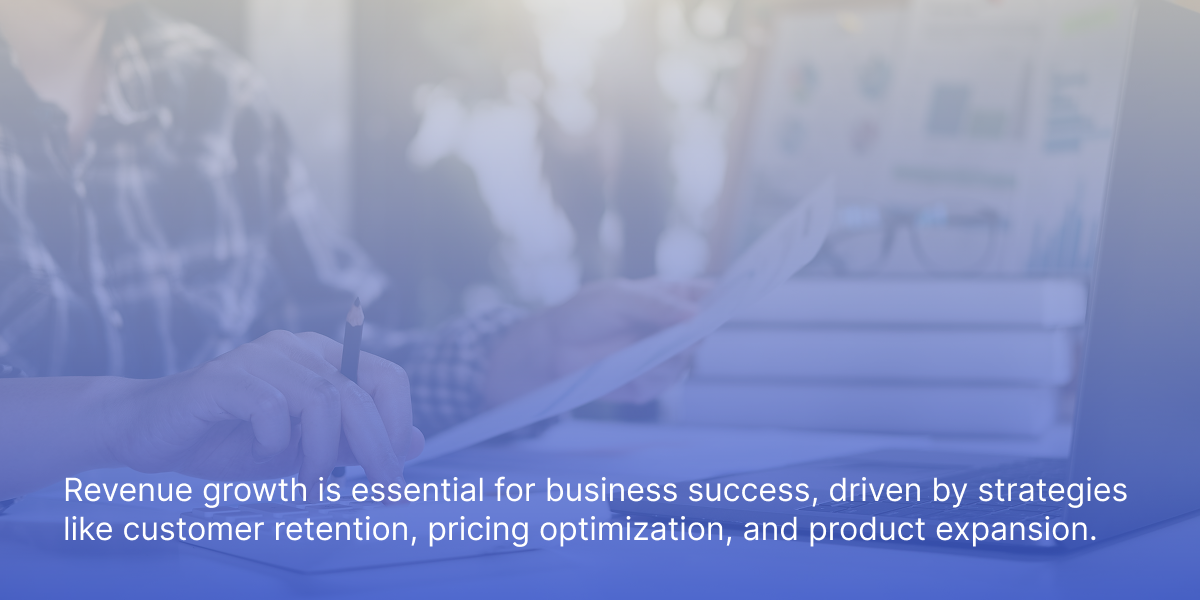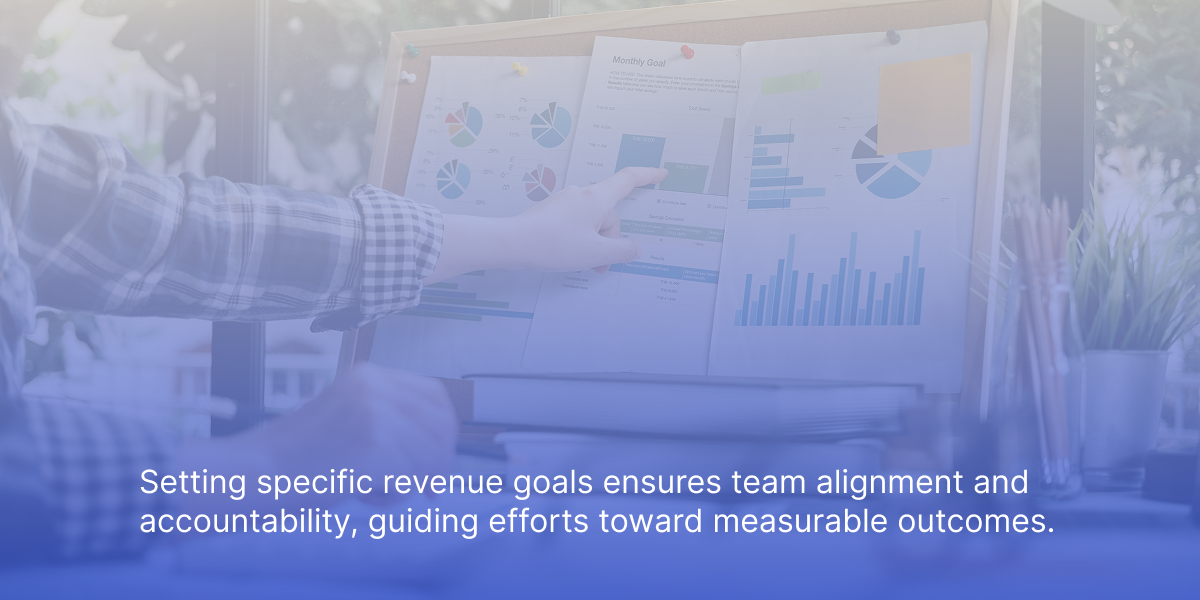Wondering how to increase revenues? This article highlights ten practical strategies to help boost your income. Expect tips on pricing, expanding offerings, customer retention, marketing, and adopting a structured business model to facilitate collaboration and drive revenue generation. Additionally, we will discuss how hosting special events and themed gatherings can attract customers effectively.
Introduction to Revenue Growth

Revenue growth can be measured by tracking key performance indicators (KPIs) such as sales revenue, customer acquisition costs, and customer lifetime value. By understanding the factors that influence revenue growth, businesses can make informed decisions to drive sales, improve customer loyalty, and increase revenue. Implementing these strategies not only helps in achieving immediate financial goals but also ensures sustainable growth in the long run.
Key Takeaways
- Set clear, measurable revenue goals to guide your team and enhance accountability.
- Adapt to market trends and customer needs by understanding and responding to customer demands, which is crucial for driving revenue growth and continuous improvement in products and services.
- Optimize pricing strategies through data analytics and value-based pricing to maximize revenue potential.
- Expand product offerings and enhance customer retention to diversify revenue streams and build brand loyalty.
- Incorporate customer feedback to refine sales strategies and improve product offerings, leading to enhanced customer satisfaction and stronger customer relationships.
Understanding Business Revenue
Business revenue refers to the total income generated by a company from its core operations and activities. Revenue can come from various sources, including sales of products or services, interest on investments, and rental income. Understanding the different revenue streams is essential for developing effective revenue growth strategies.
Businesses can increase revenue by expanding their target audience, improving pricing strategies, and enhancing customer retention. A thorough understanding of business revenue is critical for making informed decisions about investments, pricing, and resource allocation. By diversifying revenue streams and optimizing existing ones, companies can ensure a steady flow of income and better financial stability.
Set Clear Revenue Goals
Establishing precise and quantifiable objectives for revenue generation is crucial to the efficacy of any growth strategy aimed at increasing revenue. Setting sail without a clear destination, akin to sailing without a navigational aid, serves as an analogy for attempting business growth with undefined targets. These specified financial ambitions should be in line with your overarching company aims and provide guidance to your team members, aligning their efforts towards a shared end point. Additionally, these revenue goals should align with understanding and meeting customer needs, ensuring that your products and services cater to customer expectations and preferences.
To enhance financial performance, it’s important to dissect these broader revenue goals into smaller increments that are actionable and linked to critical Key Performance Indicators (KPIs). This breakdown enables you not only to track progress more effectively, but also facilitates making knowledge-based decisions by gaining valuable insights. It’s essential to regularly reevaluate these objectives taking into account the fluctuations within the marketplace so they remain pertinent and attainable. This flexibility in response to market dynamics is key. Moreover, fostering strong customer relationships is vital in achieving these revenue targets, as personalized marketing and customer feedback can drive satisfaction and loyalty, leading to increased repeat business and effective sales strategies.
By having distinct revenue targets established within your enterprise comes increased accountability across its ranks. With everyone cognizant of what they need to achieve, monitoring progress along with pinpointing potential areas needing refinement becomes much simpler. Such unified endeavor has the potency of propelling forward your organization’s ability to generate income, which may lead to scaling new operational pinnacles.
Understanding Target Markets
Identifying and understanding target markets is crucial for developing effective revenue growth strategies. A target market refers to a specific group of customers with similar needs, preferences, and characteristics. Businesses can increase revenue by tailoring their products or services to meet the needs of their target market.
Market research and data analytics can help businesses gain insights into their target market and develop targeted marketing campaigns. By understanding their target market, businesses can create effective marketing messages, improve customer satisfaction, and drive revenue growth. This targeted approach not only attracts new customers but also enhances the loyalty of existing ones, leading to sustained revenue generation.
Optimize Pricing Strategies
The implementation of effective pricing strategies can propel an increase in sales and generate additional revenue. By leveraging data analytics to gain insights into market trends and consumer buying habits, businesses are able to refine their pricing techniques with considerable impact. Research indicates that companies harnessing the power of data analytics for informed pricing decisions may see a surge in revenue by as much as 15% over competitors who do not.
Dynamic pricing is a strategic approach where prices fluctuate according to real-time market demand and competitor activities. This method enables firms to optimize instances for boosting sales volumes and enhancing profit margins. For example, many e-commerce leaders employ dynamic pricing tactics to maintain competitiveness while drawing in greater customer numbers. Ensuring your pricing strategy resonates with current market dynamics and consumer preferences can ignite interest in products or services, thus spurring on Revenue expansion. Exceptional customer service plays a crucial role in supporting dynamic pricing strategies and driving revenue growth.
Implementing value-based pricing represents yet another influential tactic. It entails setting price points based on the product’s perceived value from consumers’ perspectives instead of solely basing it off production costs. When customers perceive high value within what they purchase, they tend to be willing investors at higher price levels—this inclination effectively contributes toward amplifying overall income gains for businesses. Minor tweaks made consistently across price structures could have substantial effects on increasing profitability margins. Hence consistent refinement is vital. Value-based pricing can also enhance customer satisfaction by delivering exceptional customer experiences, leading to increased loyalty and positive referrals.
Ongoing revisions are imperative when managing your company’s approach towards its offered prices. Routinely revisit them guided by new analytical information so as always ensuring competitive advantage alongside achieving organizational objectives continuous monitoring holds potential prosperity influx steady while bolstering positions within marketplace sectors significantly.
Expand Product or Service Offerings
Introducing new products or services can draw in fresh clientele and cater to their changing needs. By expanding the variety, businesses not only grow their market share but also add value for those who already patronize them. This strategy is akin to spreading a larger net with the aim of capturing increased revenue prospects. These growth initiatives are crucial for supporting future business expansion and maintaining relevance in competitive markets.
Take, as an illustration, a cafe that decides to serve gourmet sandwiches and salads alongside its standard coffee offerings to appeal to patrons during lunch hours. Such an addition does more than just bring in new customers. It also gives existing patrons additional reasons for repeated visits. Expanding offerings to increase business revenue is essential for attracting new customers and enhancing financial performance. The advantages of diversifying your offerings are manifold: it helps reduce business risks, attract diverse customer segments, and fortify your business’s stability amidst market shifts.
Amazon stands as a prime example of this approach. They broadened their scope from selling merely books into offering an array that includes electronics, groceries, and cloud computing services among others. Through this diversification route, Amazon has been able to engage with different consumer demographics while driving considerable revenue growth. Venturing into novel product or service domains presents businesses with pivotal opportunities for expansion and maintaining competitive edge in the marketplace.
Focus on Customer Retention
Maintaining a strong base of existing customers is vital for sustained revenue enhancement. Securing the loyalty of current clients typically requires less expenditure than drawing in new patrons, with contented consumers more inclined to endorse your brand and contribute to enduring financial gain. Retaining customers can significantly increase sales by ensuring that satisfied clients continue to make purchases and recommend your business to others. Gathering and responding to consumer insights enables adjustment of services to cater effectively to shifting customer necessities and expectations, thereby boosting overall satisfaction. The deployment of robust strategies aimed at retaining customers bolsters these efforts.
Tailored communication can considerably fortify bonds with clients, heightening the probability they will make purchases. By grasping each customer’s unique preferences and requirements, it becomes possible to craft marketing messages and propositions that strike a chord with them personally. Establishing loyalty schemes represents yet another potent mechanism for preserving clientele. Such initiatives reward staunch supporters through perks that incentivize consistent patronage while also deepening emotional ties between consumers and your business—this serves not only as an incentive but also increases the perceived value over their lifetime association with your brand. Retaining loyal customers through personalized communication and loyalty programs is crucial for long-term success.
Cultivating a community centered on one’s enterprise amplifies client fidelity. Active participation by companies on digital platforms like social media along with organizing gatherings contribute towards engendering camaraderie among consumers—and prompts continued interaction as well – meanwhile extraordinary proactive service ensures elevated pleasure levels from patrons which helps diminish return rates plus nurtures repetitive commerce by delivering stellar experiences consistently.
To galvanize reliable profit proliferation via dedicated clienteles lies in concentrating attention on holding onto shoppers rather than just adding fresh ones – it entails strategizing both attraction techniques for prospective buyers alongside powerful retention plans ensuring joyousness amongst those who already support you loyally.
Invest in Marketing & Advertising
Advertising and marketing are crucial in drawing the interest of potential clients and increasing product sales. By executing targeted marketing campaigns, a company can both acquire new customers and maintain loyalty among existing ones, thereby enhancing its total revenue. The marketing department has a pivotal role in this regard. They advertise products or services to generate leads that the sales team can pursue, ensuring that those marketing efforts align with the intended target audience.
Adopting various communication channels is key to successful marketing strategies. This includes utilizing social media and online ads to attract more customers for better brand exposure and recognition, which could translate into higher sales figures. Email marketing acts as an efficient channel for reaching out directly to your prospects – considering 99% of people check their emails every day – and is highly potent for engaging with your demographic and catalyzing transactional actions.
Marketing initiatives such as Coca-Cola’s ‘Share a Coke’ illustrate how precise messaging within focused promotional activities can significantly influence consumer behavior. Employing advanced analytics when crafting your sales strategy alongside other market tactics boosts campaign effectiveness leading to improved outcomes. Essential is refining landing pages. Optimizing them garners visitor interest resulting in elevated conversion rates which ultimately maximizes returns on your advertising endeavors.
Data-Driven Decision Making
Data-driven decision making is essential for driving revenue growth and business success. Businesses can use data analytics to gain insights into customer behavior, market trends, and revenue streams. Data analytics can help businesses identify areas for improvement, optimize pricing strategies, and develop targeted marketing campaigns.
By using data to inform decision making, businesses can reduce risks, improve customer retention, and increase revenue. Data-driven decision making can also help businesses identify new growth opportunities, improve operational efficiency, and enhance customer experiences. Leveraging data ensures that business strategies are based on factual insights, leading to more effective and profitable outcomes.
Improve Operational Efficiency
Enhancing operational efficiency is a primary factor in promoting revenue growth. When businesses optimize their operations and cut down on inefficiency, they can decrease operational expenses while upholding the quality of their products. This increase in efficiency not only optimizes overall business performance but also allows for reinvestment into initiatives that Business Development, providing opportunities to augment revenue through additional streams.
Introducing automation tools stands out as an effective method to amplify operational proficiency by enabling team members to allocate more time to high-value tasks. Automation offers considerable cost savings and enhances workforce productivity. Improving efficiency through automation can lead to generating more revenue for the business. Seamless communication between departments is vital for maintaining this efficiency. Conversely, ineffective communication can lead to setbacks such as delays or missed deadlines, which streamlined processes help avoid by reducing unnecessary work duplication.
Documenting procedures helps maintain uniformity across operations and simplifies ongoing review and refinement processes — lessening the dependency on any one individual’s expertise – thus strengthening customer loyalty due to sustained product consistency, ultimately fostering repeat business alongside new sales-driven revenue growth.
Immediate advantages of improving operational efficacy encompass diminished expenses which translate into higher profitability margins. It expedites service delivery times leading back around full circle enhancing customer satisfaction with positive impacts reverberating throughout various facets of the enterprise.
Leverage Upselling and Cross-Selling
Upselling and cross-selling are vital sales strategies that enhance the value of each transaction while improving customer satisfaction. Upselling involves encouraging customers to purchase higher-end products, whereas cross selling recommends additional complementary goods. For example, an electronics store might suggest accessories alongside a primary purchase to enhance customer value and increase average order value. These tactics not only broaden customers’ awareness of available options, but also foster loyalty and contentment.
To effectively implement upselling and cross-selling, various techniques can be employed such as suggesting related products, offering package deals, or pointing out superior quality items. Customer relationship management (CRM) tools facilitate these approaches by simplifying the way your sales team identifies opportunities to propose supplementary products or services. Incentives like discounts or free shipping can amplify these strategies to increase uptake on upsells, making them more attractive for consumers, which in turn bolsters sales figures.
Customers who have a history with a brand often display less concern over prices, making them prime targets for upsell and cross-sell initiatives. By curating an explicit strategy directed at promoting pricier commodities through upselling methods, you direct your sales force towards securing enhanced outcomes. Effective sales strategies are crucial for converting leads into paying customers. The application of technological aids supports this endeavor by providing cues for staff members to recommend additions while notifying shoppers about beneficial pricing options available to them.
Enhance Online Presence
Establishing a robust online presence is essential for increasing revenue in today’s digital age. The initial interaction potential customers often have with your brand is through your website, and its appeal can heavily influence their impression of you. By investing in an up-to-date, accessible website and optimizing it for search engine visibility (SEO), you can improve your stature within the realm of online sales and draw in additional clientele. Additionally, adopting subscription models can generate recurring revenue, ensuring stable and predictable income while enhancing customer loyalty.
Social media engagement also plays a key role in bolstering your virtual footprint. Research indicates that 91% of consumers are more inclined to visit a company’s webpage after engaging with them on social networks. Paid promotions such as online ads enable businesses to secure prominent positioning within search results, targeting individuals who demonstrate strong purchase intent. Email marketing establishes an uninterrupted connection with prospective clients, with data showing 99% of people checking their emails every day. A strong online presence is crucial to retain customers and drive repeat business.
Maintaining consistent details across all internet listings significantly contributes to a business’s authenticity. This uniformity is something Google takes into account when determining local search rankings. A pronounced market presence heightens the likelihood that potential buyers will encounter your offerings since 97% utilize the web to find local goods or services—a critical aspect given most searches start there – thus attracting additional patrons and propelling substantial advancement in revenue generation.
Enter New Markets
Delving into fresh markets serves as an influential tactic to uncover opportunities for growth and escalate revenue. This process requires a deep understanding of the market dynamics and customization of your offerings to align with them. Entering new markets can stimulate demand by driving interest in your products among new customer bases. Conducting extensive market research, gathering customer insights, and scrutinizing the competitive landscape are critical components in devising successful strategies for introducing products into international markets.
Conducting thorough market research helps identify potential opportunities and tailor strategies effectively for maximum revenue generation. Initiating pilot campaigns in these new territories can help pinpoint any potential obstacles before proceeding with a widespread release. Adapting both your product offerings and marketing initiatives to resonate with local consumers strengthens connections with this emerging clientele. While diversification involves venturing into completely novel markets with newly developed products – thus presenting greater risk – it has the capacity to substantially augment revenue through engagement with untapped customer segments by fulfilling unmet needs within those markets.
The Ansoff matrix offers a strategic framework employed frequently for planning product expansion. It distinguishes tactics based on leveraging existing versus developing new products or entering established versus uncharted markets. By breaking into untouched markets, businesses have the advantage to pursue robust growth possibilities, draw in fresh consumer bases, and catalyze impressive upticks in their revenue streams.
Implement a Loyalty Program
Loyalty programs serve as an influential mechanism to foster customer loyalty and establish a sentimental bond with your brand. By providing personalized rewards that cater to individual customer tastes and delivering superior customer service, you can heighten engagement levels and promote repeat patronage. Implementing tiered rewards within these programs is a common strategy used to encourage increased expenditure.
Maintaining consistent dialogue about the advantages of participating in loyalty programs ensures customers are well-aware and enticed to engage. Soliciting opinions from patrons on the program’s effectiveness allows for fine-tuning of incentives, thereby improving overall customer satisfaction. The adoption of such a program plays a critical role in bolstering long-term loyalty among consumers, ultimately resulting in sustained revenue expansion. Additionally, loyalty programs are essential for generating sufficient revenue, which is crucial for covering operational costs and funding growth initiatives.
Tracking Revenue Metrics
Tracking revenue metrics is crucial for measuring revenue growth and making informed decisions. Key revenue metrics include sales revenue, customer acquisition costs, customer lifetime value, and profit margins. Businesses can use revenue metrics to evaluate the effectiveness of their revenue growth strategies and identify areas for improvement.
By tracking revenue metrics, businesses can optimize their pricing strategies, improve customer retention, and increase revenue. Regularly reviewing and analyzing revenue metrics can help businesses stay on track, achieve their revenue goals, and drive long-term growth and success. This continuous monitoring ensures that businesses can adapt to market changes and maintain a competitive edge.
Summary
To summarize, propelling the growth of business revenue demands a comprehensive strategy encompassing well-defined revenue targets, refined pricing techniques, broadened product ranges, and an emphasis on retaining customers. Pouring resources into marketing endeavors and advertising initiatives, boosting operational effectiveness, capitalizing on opportunities for upselling and cross selling practices, fortifying your online visibility, venturing into new marketspaces, and enacting loyalty schemes are all potent strategies to augment business income. Embracing these methodologies can lead to an ongoing enhancement in revenue generation and secure a competitive advantage within the market environment.
Frequently Asked Questions
Why is setting clear revenue goals important?
Establishing precise revenue targets is essential as it coordinates the concentration of your team, ensures collective responsibility, and lays out a clear path to achievement. Setting clear goals also helps in understanding and meeting customer demands, which is crucial for driving revenue growth and continuous improvement in products and services.
This action forms a pathway toward reaching your company’s aims with intentionality and guidance!
How can optimizing pricing strategies boost revenue?
Optimizing your pricing strategies can lead to a considerable increase in revenue, as it allows for adjustments based on market demand and the maximization of sales opportunities, which ultimately enhances profit margins. By delivering exceptional customer experiences through optimized pricing, you can significantly enhance customer satisfaction, leading to increased repeat business and positive referrals.
Adopt dynamic pricing to maintain a competitive edge and witness your profits soar!
What are the benefits of expanding product or service offerings?
Expanding your product or service offerings is a powerful way to attract new customers and meet their evolving needs.
By incorporating growth initiatives, you support business expansion and ensure successful revenue generation strategies. This approach increases your market share and enhances the value you provide, driving your success forward!
How can customer retention strategies impact revenue growth?
Implementing customer retention strategies like personalized interactions and loyalty programs can significantly boost revenue growth by reducing costs and fostering loyal customers.
Invest in your customers, and watch your revenue predictably soar!
Why is a strong online presence crucial for revenue growth?
A strong online presence is vital for revenue growth because it boosts visibility and credibility, effectively attracting more customers to your business.
Embrace the digital landscape to unlock greater opportunities for success!










